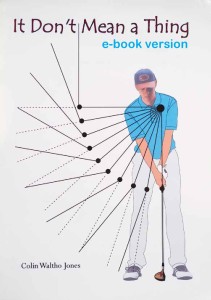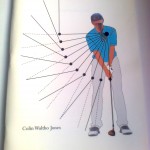Format: Medal
Venue: [Home course]
Score: ?
Handicap mark: 4.0
Themes in reply: Slow play, strokeplay, concentration
Hi Colin,
As I have said, Saturday was very disappointing. I got myself into a great position after 5 holes and let it go. The conditions were very difficult, the course was bouncy and there was a strong South easterly wind. Eg. We were hitting driver into the par 3 4th.
I won’t go into all my shots but a couple of things went wrong. It was extremely slow and I got impatient with the group(s) in front. We waited on nearly every shot on the front 9 . It took us 2 hours to play 8 holes as a two ball.
I also made a few bad club selections. Having been -2 for 5 holes I had bogey on the 6th and 7th.
Dear John,
Bad luck, old boy. Slow play is a killer.
The subconscious hits shots by locating “timing”. The subconscious needs vivid messages to work properly (sabre-toothed tiger). Golf’s main challenge to its proficient practitioners takes place in the time that elapses between the shots because it is in this time that the conscious has the opportunity to take over from the subconscious and the subconscious is motivated to go to sleep because of the lack of vivid messages telling it that its services are required. Slow play exacerbates this in-built problem facing players of golf. It would be difficult enough in match-play, but in the virtually “non-sport” that is strokeplay golf, it is intolerable.
In addition to the problem that slow play presents to all players there is the matter of your natural temperament, which, if I may be so bold, is a sort of controlled hyper-activity. When you were little I bet your Mam told you a thousand times that you had “ants in your pants”. And the speed, and impatience, with which you play your casual foursomes with your highly proficient friends is really quite impressive. Slow play is one of those external factors that I mentioned in my last letter which have the ability to derail one’s competitiveness. The question is when does an uncontrollable external factor become an excuse? Or, when does an external factor have such an uncontrollably negative impact on your play that it is best to forget the resulting outcome?
I think that slow play in a strokeplay event is nearly insurmountable as an impediment to sporting competitiveness: it would certainly make me take up another sport. I couldn’t commit that amount of time to something that was so inherently “wrong”.
On the 8th I was in the semi-rough but not a great lie. It’s a par 5 so I should have laid up and then knocked a wedge onto the green and 2 putted for a 5. Instead, as it was downwind and a birdie chance I attempted to hit my rescue wood. It wasn’t a great shot and I found a terrible lie further down in the rough. The result was another bogey.
We then had a wait of about 6/7 minutes on the next tee while the group in front looked for their ball. I hit a really poor 3 wood tee shot and this lead to another bogey.
Anyway, 2 over par after 9 was ok and I would have taken that before we started.
The 10th was downwind and driveable. My biggest mistake of the day was going for it with the driver. I ended up with a 7.
On the 11th – par 3 – my 3 wood just rolled into the bunker nicely under the lip – no shot! Ended up with a 5. By this time I was extremely pissed off and nothing seemed to go right thereafter.
I don’t know why I started chasing a score. The 8th and 10th were really bad club selections. I also lost my rhythm and timing.
The thing is I’m playing ok and I just know there a good score waiting to come out.
Playing in a comp on Monday so I’ll let you know how it goes.
Thanks for you patience and sorry you lost the bowls!
Regards,
John
8th – The key to the second out of the rough is the bogeys on the preceding two holes. At this point you were still level par, going well but needing to consolidate the front nine with a couple of pars. Taking on such a difficult shot under those circumstances, I can only think that you were already too annoyed at having to wait on every hole to make a rational choice of shot.
Taking on a difficult shot like that would have been fine if you could have brought every ounce of mental energy to the routine (visualisation etc): there is nothing wrong at all in being “brave” if you can authentically “see” the shot. But being annoyed would have robbed you of the absolute clarity you would have required to “see” that shot. In fact, a wild thrash out of the rough with a rescue club was probably an expression of your frustration at the turn of events.
10th – I just want to pick up on that word “driveable”. The danger in the word is that it has the capacity to replace your visualisation with an opinion. Do you remember a previous e-mail where I took you to task for playing “a little 7-iron”, I think it was. The issue is the same. To drive the 10th you need a strong sense of what it is going to take to play the shot. This would be a good test of your imagination because it is not a shot that you would get to play very often. Also, a drive of that length would normally be to a larger and less risky target.
So, stood on the 10th tee, you are faced with “seeing” a shot you play rarely (a drive onto the green) with a type of shot that you play frequently (a drive off a tee peg) to a different type of target (a green). There is nothing at all wrong with this it is just that it is a formidable challenge to your imaginative powers.
The word “driveable” encapsulates a general opinion about the shot you are facing and gets in the way of your ability to formulate a specific visualisation of the shot. At the very least this is unhelpful, especially as you are already short of imaginative energy because you are annoyed and starting to chase the round.
Opinions are one of the challenges that stem directly from the huge amount of time the golfer has between shots: a challenge made all the more formidable (and tedious) by slow play. They are an insidious threat because there’s nothing wrong with the opinion; it is just that it is an opinion about the general that weakens the view of the specific.
Overall
You need to forget this one. I’m glad you mentioned that you are playing well. Not every type of tournament on any particular day is going to suit you. If you need to take anything from this process then it would be that you need to be able to distract yourself when there are delays. Also, you need to remind yourself that each shot in a round is independent of every other. Each shot is a matter of finding “timing” so that the ball has the best possible chance of moving from Position A to desired Position B. If there are delays, then it is a real test of your ability to move through your concentration zones and back out again.
Zoning concentration
Zone A – Starts the moment you finish a shot. In this zone you need to think about nothing in particular and just let your heightened awareness absorb everything you need to absorb about the state of the match (round) and the conditions. Avoid forming concrete opinions. Gently distract yourself with conversation. Be interested in your opponent or partner’s play.
Zone B – Starts at some point just before you know it is definitely going to be your turn. Choosing the right moment to switch from Zone A into Zone B is a matter of judgement and will reflect your experience and games-playing intelligence. If you switch too early you will not be able to maintain the high level of concentration required to keep your subconscious switched on. If you switch too late you will not have sufficient time to get through the routine of visualisation etc. Choosing the right moment to switch is a very important skill and not one to be taken lightly.
In Zone B you will choose the shot and the club to play it. You will then stand behind the ball and visualise the flight and landing spot. You will then constantly replay this image as you take up your stance and make minute adjustments to your grip. You will stay muscularly relaxed so that the image of the shot can position you correctly and get the club to feel right in your hands.
Zone C – Starts at the point that you are ready to take the shot. Zone C lasts only a few moments and takes fierce concentration to remember to go there! In Zone C you will drop the image of the shot and replace it with a “visualisation” of the feel and rhythm of the shot. At this point you need to be “lost to the world” and completely swamped with the sweet pendulumic rhythm that is going to give you that perfect shot. As I said, this zone last but a few moments and is very intense.
So, a shot’s concentration zones look like this:
Zone A . . . . . . . . . . . . . . . . . . . . . .Zone B . . . . . . . . Zone C . . Zone A . . . . . . . . . . . .
Good luck tomorrow,
Colin


